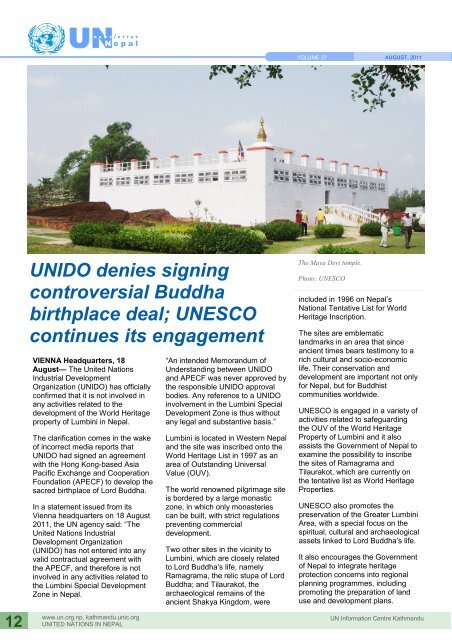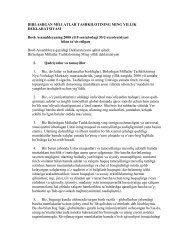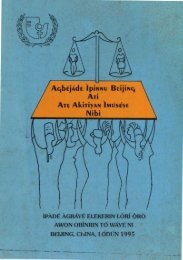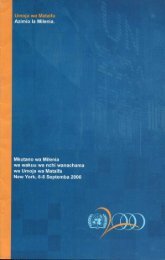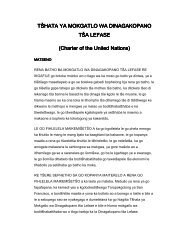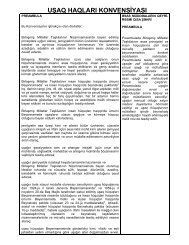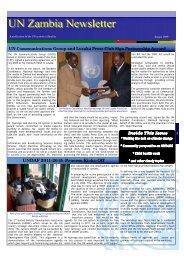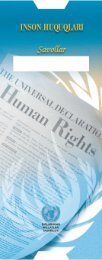Download Newsletter - United Nations Information Centres
Download Newsletter - United Nations Information Centres
Download Newsletter - United Nations Information Centres
Create successful ePaper yourself
Turn your PDF publications into a flip-book with our unique Google optimized e-Paper software.
12<br />
UN n e w s l e t t e r<br />
N e p a l<br />
UNIDO denies signing<br />
controversial Buddha<br />
birthplace deal; UNESCO<br />
continues its engagement<br />
VIENNA Headquarters, 18<br />
August— The <strong>United</strong> <strong>Nations</strong><br />
Industrial Development<br />
Organization (UNIDO) has officially<br />
confirmed that it is not involved in<br />
any activities related to the<br />
development of the World Heritage<br />
property of Lumbini in Nepal.<br />
The clarification comes in the wake<br />
of incorrect media reports that<br />
UNIDO had signed an agreement<br />
with the Hong Kong-based Asia<br />
Pacific Exchange and Cooperation<br />
Foundation (APECF) to develop the<br />
sacred birthplace of Lord Buddha.<br />
In a statement issued from its<br />
Vienna headquarters on 18 August<br />
2011, the UN agency said: ―The<br />
<strong>United</strong> <strong>Nations</strong> Industrial<br />
Development Organization<br />
(UNIDO) has not entered into any<br />
valid contractual agreement with<br />
the APECF, and therefore is not<br />
involved in any activities related to<br />
the Lumbini Special Development<br />
Zone in Nepal.<br />
www.un.org.np, kathmandu.unic.org<br />
UNITED NATIONS IN NEPAL<br />
―An intended Memorandum of<br />
Understanding between UNIDO<br />
and APECF was never approved by<br />
the responsible UNIDO approval<br />
bodies. Any reference to a UNIDO<br />
involvement in the Lumbini Special<br />
Development Zone is thus without<br />
any legal and substantive basis.‖<br />
Lumbini is located in Western Nepal<br />
and the site was inscribed onto the<br />
World Heritage List in 1997 as an<br />
area of Outstanding Universal<br />
Value (OUV).<br />
The world renowned pilgrimage site<br />
is bordered by a large monastic<br />
zone, in which only monasteries<br />
can be built, with strict regulations<br />
preventing commercial<br />
development.<br />
Two other sites in the vicinity to<br />
Lumbini, which are closely related<br />
to Lord Buddha‘s life, namely<br />
Ramagrama, the relic stupa of Lord<br />
Buddha; and Tilaurakot, the<br />
archaeological remains of the<br />
ancient Shakya Kingdom, were<br />
VOLUME 37 AUGUST, 2011<br />
The Maya Devi temple.<br />
Photo: UNESCO<br />
included in 1996 on Nepal‘s<br />
National Tentative List for World<br />
Heritage Inscription.<br />
The sites are emblematic<br />
landmarks in an area that since<br />
ancient times bears testimony to a<br />
rich cultural and socio-economic<br />
life. Their conservation and<br />
development are important not only<br />
for Nepal, but for Buddhist<br />
communities worldwide.<br />
UNESCO is engaged in a variety of<br />
activities related to safeguarding<br />
the OUV of the World Heritage<br />
Property of Lumbini and it also<br />
assists the Government of Nepal to<br />
examine the possibility to inscribe<br />
the sites of Ramagrama and<br />
Tilaurakot, which are currently on<br />
the tentative list as World Heritage<br />
Properties.<br />
UNESCO also promotes the<br />
preservation of the Greater Lumbini<br />
Area, with a special focus on the<br />
spiritual, cultural and archaeological<br />
assets linked to Lord Buddha‘s life.<br />
It also encourages the Government<br />
of Nepal to integrate heritage<br />
protection concerns into regional<br />
planning programmes, including<br />
promoting the preparation of land<br />
use and development plans.<br />
UN <strong>Information</strong> Centre Kathmandu


